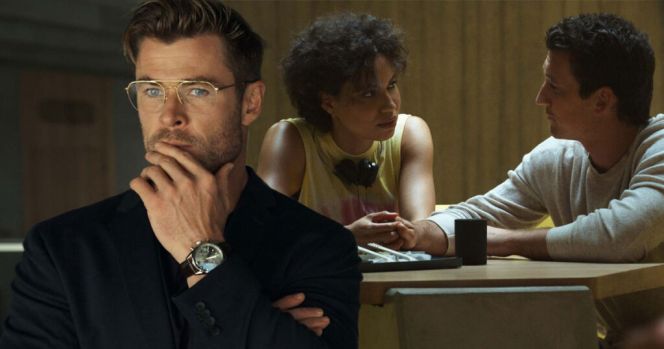MOVIE REVIEW – Director Joseph Kosinski returns to the big screen with Spiderhead, which seems like record time considering his film Top Gun: Maverick, postponed due to a pandemic, was released just three weeks ago. Suppose that sequel was intended to short-circuit the higher functions of the audience by appealing to nostalgia and working on the adrenal gland. In that case, the newer film is a smaller-scale, primarily interior, Covid-ridden production that seeks to ponder the deep mysteries of the human mind.
And the pedigree of Spiderhead is impeccable. And now we have the director, Joseph Kosinski, whose unremarkable little film, Top Gun: Maverick, which we recently wrote about, was not only great (in our opinion) but also a huge box office success. And one of the stars of this latest film is Chris Hemsworth, a star of Marvel movies and other action movies, who has already proven himself in a previous Netflix movie, The Exorcism. The other main character is Miles Teller, the other star of the aforementioned Top Gun: Maverick, alongside Tom Cruise. And we haven’t even mentioned that the film is based on the brilliant short novel Escape from Spider’s Head, published in the New Yorker and written by the talented George Saunders. The original is a gritty, brutal story, well worth a read for those who understand English. What could possibly go wrong here?
This new kind of prison is not as much fun as it first seemed…
In this adaptation of Saunders’ work, the film’s original title, ‘Spiderhead’, is the name of a prison and research centre where inmates are used as experimental subjects for psychotropic drugs. These drugs, administered from packets implanted in the base of the spine, are used for all sorts of purposes. They can turbocharge the libido, turn air pollution into rainbow ring clouds, or induce terror at the sight of a staple gun.
The research leader, Steve Abnesti, is played by Chris Hemsworth: a charming, handsome, fake-fat scientist with trendy aviator glasses in a setting that most resembles the secret base of the James Bond movie villains. He is smiling, good-humoured, and coolly lecturing on how to make the world a better place to anyone who will listen (or is forced to listen), and occasionally berating his assistant Mark (Mark Paguio) for not refreshing the coffee.
Participants in the research: the environment is supposed to be a massive party for the prisoners because instead of languishing in some filthy and cruel execution facility, everything here – apart from the specific experiments – is like some kind of poisonous holiday resort or sanatorium, with quality food, a first-class recreation department and the dreamlike, beautiful surroundings of an exotic island. But something, something, isn’t it? If only those inhuman experiments weren’t…
Chris Hemsworth as the handsome Dr. Evil
So, the basic idea is not bad, but unfortunately, the direction, the script and the acting leave much to be desired. Hemsworth himself seems to relish the role of the handsome Dr. Evil: he plays his character’s indifference to his unsubstantiated experiments and ethical lapses with glee. There’s a bit of Dr. Mengele and a bit of a Mark Zuckerberg in there too. “Crossing boundaries is nothing to worry about anymore,” Steve tells Mark with a wave of his hand. He’s so relaxed he’s almost falling apart.
But it’s not Hemsworth’s acting or character that’s the problem; it’s more the way it’s embedded in the story. Hemsworth isn’t a bad actor and would make a good villain, but the character he plays still often feels like a bad rip-off because of the clunky dialogue and scenes.
But the antics of the other main character, Jeff (Miles Teller), aren’t much more impressive. Jeff broods over the horrific car accident that landed him in jail, replaying the events repeatedly, with a twist of the script thrown in for good measure. His mental anguish is nursed by his new love Lizzy (Jurnee Smollett), who, of course, will also discover her own tragedy.
These are all not uninteresting things, but Kosinski’s speciality is tangible action scenes with planes and explosions, not people tormented by guilt and punishment in a horror setting. The aforementioned dramatic scenes are weak enough on their own but embedded in the main story of the evil experiments; they are particularly weak. While we can admire Kosinski’s ambition to make a cerebral blockbuster, this script (by Rhett Reese and Paul Wernick) would have been better suited to a David Cronenberg or Steven Soderbergh, who know their way around such films, not a director who is at home with Top Gun-style blockbusters.
Mixing styles and inane philosophising
Kosinski also did his best to make the production in Australia stylish and spectacular. The prison, located on a remote island, is reminiscent of some kind of post-apocalyptic science fiction. The room where Jeff and the other inmates are observed after the dosing is wittily reminiscent of a talk-show set with yellow armchairs. And the soundtrack is full of the 1970s and ’80s catchy tunes. The problem is, however, that these stylistic elements are hard to fit together, while the script constantly operates with cheap and implausible twists.
In addition, Kosinski fails to make the silly philosophising about free will sound profound or novel, and the hectic, rushed finale, lacking any exciting underlying concept or elaboration of the original story, comes across as a botched experiment that exploded in the lab.
-BadSector-
Spiderhead
Direction - 4.8
Actors - 6.4
Story - 4.2
Visuals/Music/Sounds - 6.8
Ambience - 3.8
5.2
AVERAGE
Kosinski also did his best to make the production in Australia stylish and spectacular. The prison, located on a remote island, is reminiscent of some kind of post-apocalyptic science fiction. The room where Jeff and the other inmates are observed after the dosing is wittily reminiscent of a talk-show set with yellow armchairs. And the soundtrack is full of the 1970s and ’80s catchy tunes. The problem is, however, that these stylistic elements are hard to fit together, while the script constantly operates with cheap and implausible twists. In addition, Kosinski fails to make the silly philosophising about free will sound profound or novel, and the hectic, rushed finale, lacking any exciting underlying concept or elaboration of the original story, comes across as a botched experiment that exploded in the lab.

















Leave a Reply